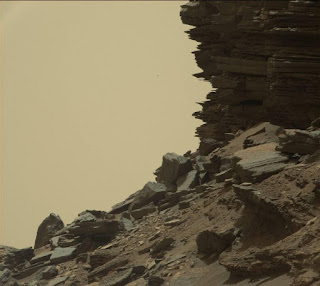The layered geologic past of Mars is revealed in stunning detail in new color images returned by NASA's Curiosity Mars rover, which is currently exploring the "Murray Buttes" region of lower Mount Sharp. The new images arguably rival photos taken in U.S. National Parks.
Curiosity took the images with its Mast Camera (Mastcam) on Sept. 8. The rover team plans to assemble several large, color mosaics from the multitude of images taken at this location in the near future.
"Curiosity's science team has been just thrilled to go on this road trip through a bit of the American desert Southwest on Mars," said Curiosity Project Scientist Ashwin Vasavada, of NASA's Jet Propulsion Laboratory, Pasadena, California.
The Martian buttes and mesas rising above the surface are eroded remnants of ancient sandstone that originated when winds deposited sand after lower Mount Sharp had formed.
"Studying these buttes up close has given us a better understanding of ancient sand dunes that formed and were buried, chemically changed by groundwater, exhumed and eroded to form the landscape that we see today," Vasavada said.
The new images represent Curiosity's last stop in the Murray Buttes, where the rover has been driving for just over one month. As of this week, Curiosity has exited these buttes toward the south, driving up to the base of the final butte on its way out. In this location, the rover began its latest drilling campaign (on Sept. 9). After this drilling is completed, Curiosity will continue farther south and higher up Mount Sharp, leaving behind these spectacular formations.
Curiosity landed near Mount Sharp in 2012. It reached the base of the mountain in 2014 after successfully finding evidence on the surrounding plains that ancient Martian lakes offered conditions that would have been favorable for microbes if Mars has ever hosted life. Rock layers forming the base of Mount Sharp accumulated as sediment within ancient lakes billions of years ago.
On Mount Sharp, Curiosity is investigating how and when the habitable ancient conditions known from the mission's earlier findings evolved into conditions drier and less favorable for life.
Image Credit: NASA/JPL-Caltech/MSSS
Explanation from: http://www.jpl.nasa.gov/news/news.php?feature=6618








Beautifully dead
ReplyDeleteAmazing
너무나도 환성적이내요
ReplyDeleteWould mars have silver & gold on it ?
ReplyDelete